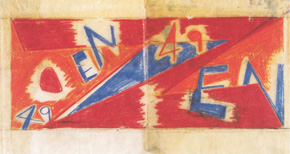|
Through his participation in the traveling exhibition 'Extreme Malerei' (Extreme Painting), initially shown in February 1947 at the Schaezlerpalais in Augsburg, Rupprecht Geiger meets the then British consul John Anthony Thwaites, who is one of the earliest and most decisive supporters of his art. The third show of modern art is the first attempt since the end of the war to present the most important styles of the post-war period by means of striking representatives. During the first years of the war, a kind of discussion group of abstract artists takes place in Thwaites' apartment, in which Geiger soon participates. Participants are the painters Gerhard Fietz, Willi Hempel, Willi Baumeister, the sculptor Brigitte Meier-Denninghoff (later Matschinsky-Denninghoff) and the art historian Ludwig Grote. From February 1948, the newly opened Moderne Galerie Stangl provides another platform for exchange. The artists Rolf Cavael and Fritz Winter as well as the art historian Franz Roh join the circle. Following a studio visit, during which Thwaites reveals to Geiger his proposal to form a group of artists, the two present this idea to the discussion circle for discussion. In the Stangl Gallery, on July 19, 1949, after the opening of a Cavael exhibition, they founded the "Group of 'Non-Objective' South German Painters." The initial members were Cavael, Fietz, Geiger, Hempel and Winter. They are soon joined by Baumeister and Meier-Denninghoff. Thwaites, the art historians Grote and Roh, and the gallery owner Stangl supported the artists in an advisory and promotional capacity. In a letter to Theodor Werner dated July 25, 1949, Fietz justifies the founding of the artists' group as follows: "The current situation in the public and in art life urges a union of abstract painters in order to form an intellectual front and to give abstract art stronger resistance through joint exhibitions." Following the tradition of the 'Blaue Reiter', the central concern of the group is "to spread abstract painting through image and word, so that it becomes common property, i.e. that it becomes the determining form of expression of our time" (Proposals for a Community of Interest). As an artistic, binding program a decided turning away from the imitation of nature is demanded. No common style, but abstraction as a symbol of artistic freedom is striven for. The militant approach of the group is to be understood in connection with the radical turning away from the recent past or with the political task of a cultural renewal of Germany. The necessary artistic exchange, the desired social acceptance as well as the economic success associated with it induced many artists to join together in groups and thus to overcome the isolation that was often encountered at that time. |
 In search of a representative name, the group of artists is renamed 'ZEN 49' after controversial discussions in the last months of 1949. The renaming presumably goes back to the suggestion of Geiger, who at that time was concerned with the idea of Zen Buddhism. In the abstract sign language or the abstract attitude towards life of the Zen monks he sees a possible parallel to abstract painting. The preoccupation with Far Eastern philosophy and art, which can already be found in Kandinsky's work, expanded noticeably after the Second World War, as the popularity of the books on Zen published in the first post-war years shows. The first exhibition of the artist group ZEN 49 took place in April 1950 at the Central Art Collecting Point in Munich. About the exhibition Roh writes that the members of ZEN 49 concentrate on "completely non-objective design" and that they "no longer want to include the external reality of the world of things [...] in painting and sculpture in the slightest." In addition to the founding members, other artists, such as Hilla von Rebay, who was appointed an honorary member, were invited to exhibit with the group as a sign of its openness and internationality. Despite the adoption of exhibitions by other German cities and the largely positive reviews, the desired success does not occur until later. This success is evidenced by the uninterrupted growth of membership and the last exhibition of the group ZEN 49 in Germany in 1955, which was reported to unite "the German elite of abstract art". An exhibition tour of American colleges in 1956/57 is on the one hand a high point, but on the other hand marks the end of the group. Without ever disbanding, the group falls apart. This happens because it has fulfilled its 'mission' - to establish abstract or non-objective art in Germany. In addition, most of the members have achieved the recognition they had hoped for. Rupprecht Geiger's public reputation rises steadily in the early fifties: in 1951 he receives his first public commission in the field of art in construction with the design of the façade of Munich Central Station and is awarded the prestigious Domnick Art Prize. In 1953 the Munich Moderne Galerie Otto Stangl and the Cologne Galerie der Spiegel organize the artist's first solo exhibitions. Author: Julia Geiger |
